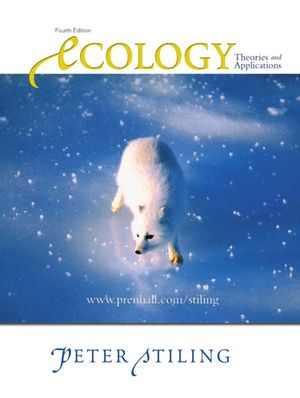Vi har bytt namn till Adlibris Campus! Campusbokhandeln ❤️ Adlibris - Läs mer här

Ecology | 4:e upplagan
- Inbunden, Engelska, 2001
- Författare: Peter Stiling
- Betyg:
Från
236
kr
Kan hämtas i Linköping.
Fler utgåvor i lager
Beskrivning
Most chapters end with Applied Ecology</D>, Summary and Discussion Questions.
What Is Ecology? Ecological Methods. Spatial Scale.
Evolutionary History. Genetic Mutation. Measuring Genetic Variation. Genetic Variation and Population Size.3. Extinction.
The Extinction Crisis. Patterns of Extinction. Endangered Species. Species Characteristics and Extinction.4. Group Selection and Individual Selection.
Group and Individual Selection. Altruism. Group Living.5. Life History Strategies.
Reproductive Strategies. Age Structure. Mating Systems.
Life Tables. Reproductive Rate. Deterministic Models: Geometric Growth. Stochastic Models.7. Physical Environment.
Physical Variables. Physical Factors and Species. Physical Factors and Numbers of Species.8. Competition and Coexistence.
Species Interaction. Intraspecific Competition. Interspecific Competition: Laboratory Experiments. The Frequency of Competition. Modeling Competition. Coexistence of Species.9. Mutualism
Plant-Pollinator Mutualism. Seed Dispersal. A Variety of Mutualisms. Modeling Mutualism. Mutualisms and Community Process. Commensalism.10. Predation.
Antipredator Adaptations. Predator-Prey Models. Field Studies of Predator-Prey. Introduced Predators. Field Experiments with Natural Systems.11. Herbivory.
Plant Defenses. Modeling Herbivory. Effects of Herbivores on Plants. Effects of Plants on Herbivores. Herbivory Affects Community Structure.12. Parasitism.
Defining Parasites. Defense against Parasites. Modeling Parasitism. Parasites Affect Host Populations. Parasites Affect Communities. Parasites and Biological Control.13. Evaluating the Controls on Population Size.
Comparing the Strengths of Mortality Factors. Density Dependence. Metapopulations. Conceptual Models of Population Control.
Are Communities More than the Organisms They Comprise? Climate and Community Structure. Classification of Communities. Terrestrial Communities. Aquatic Communities.15. Global Patterns in Species Richness.
Explanations of Species Richness Gradients. Community Similarity. Global Species Richness. Preserving Species Richness. Species Richness and Community Function.16. Species Diversity.
Diversity Indices. Rank Abundance Diagrams. Community Similarity. Cluster Analysis.17. Stability, Equilibrium, and Nonequilibrium.
Community Stability. Is There a Link between Diversity and Stability? Experimental Tests of the Diversity-Stability Hypothesis. The Intermediate-Disturbance Hypothesis.18. Succession.
Development of Communities. Facilitation. Inhibition. Tolerance and Other Patterns of Succession. Patterns in Species Richness during Succession. Biotic Interactions and Succession.19. Island Biogeography.
Theory of Island Biogeography. Species-Area Effects. The Effect of Distance on Island Immigration. Species Turnover.20. Trophic Structure.
Food Web Complexity. Food Web Patterns. Problems with Food Web Patterns. Guilds. Keystone Species.21. Energy Flow.
Measuring Production. Limits to Primary Production. Patterns in Primary Production. Secondary Production. The Limits to Secondary Production.22. Nutrients.
Soils. Nutrient Availability. Light. Organismal Effects on Nutrient Availability.Glossary.
Literature Cited.
Photo Credits.
Index.
I. INTRODUCTION.
1. Why and How to Study Ecology.What Is Ecology? Ecological Methods. Spatial Scale.
II. EVOLUTION AND BEHAVIORAL ECOLOGY.
2. Genetics and Ecology.Evolutionary History. Genetic Mutation. Measuring Genetic Variation. Genetic Variation and Population Size.3. Extinction.
The Extinction Crisis. Patterns of Extinction. Endangered Species. Species Characteristics and Extinction.4. Group Selection and Individual Selection.
Group and Individual Selection. Altruism. Group Living.5. Life History Strategies.
Reproductive Strategies. Age Structure. Mating Systems.
III. POPULATION ECOLOGY.
6. Population Growth.Life Tables. Reproductive Rate. Deterministic Models: Geometric Growth. Stochastic Models.7. Physical Environment.
Physical Variables. Physical Factors and Species. Physical Factors and Numbers of Species.8. Competition and Coexistence.
Species Interaction. Intraspecific Competition. Interspecific Competition: Laboratory Experiments. The Frequency of Competition. Modeling Competition. Coexistence of Species.9. Mutualism
Plant-Pollinator Mutualism. Seed Dispersal. A Variety of Mutualisms. Modeling Mutualism. Mutualisms and Community Process. Commensalism.10. Predation.
Antipredator Adaptations. Predator-Prey Models. Field Studies of Predator-Prey. Introduced Predators. Field Experiments with Natural Systems.11. Herbivory.
Plant Defenses. Modeling Herbivory. Effects of Herbivores on Plants. Effects of Plants on Herbivores. Herbivory Affects Community Structure.12. Parasitism.
Defining Parasites. Defense against Parasites. Modeling Parasitism. Parasites Affect Host Populations. Parasites Affect Communities. Parasites and Biological Control.13. Evaluating the Controls on Population Size.
Comparing the Strengths of Mortality Factors. Density Dependence. Metapopulations. Conceptual Models of Population Control.
IV. COMMUNITY ECOLOGY.
14. The Main Types of Communities.Are Communities More than the Organisms They Comprise? Climate and Community Structure. Classification of Communities. Terrestrial Communities. Aquatic Communities.15. Global Patterns in Species Richness.
Explanations of Species Richness Gradients. Community Similarity. Global Species Richness. Preserving Species Richness. Species Richness and Community Function.16. Species Diversity.
Diversity Indices. Rank Abundance Diagrams. Community Similarity. Cluster Analysis.17. Stability, Equilibrium, and Nonequilibrium.
Community Stability. Is There a Link between Diversity and Stability? Experimental Tests of the Diversity-Stability Hypothesis. The Intermediate-Disturbance Hypothesis.18. Succession.
Development of Communities. Facilitation. Inhibition. Tolerance and Other Patterns of Succession. Patterns in Species Richness during Succession. Biotic Interactions and Succession.19. Island Biogeography.
Theory of Island Biogeography. Species-Area Effects. The Effect of Distance on Island Immigration. Species Turnover.20. Trophic Structure.
Food Web Complexity. Food Web Patterns. Problems with Food Web Patterns. Guilds. Keystone Species.21. Energy Flow.
Measuring Production. Limits to Primary Production. Patterns in Primary Production. Secondary Production. The Limits to Secondary Production.22. Nutrients.
Soils. Nutrient Availability. Light. Organismal Effects on Nutrient Availability.Glossary.
Literature Cited.
Photo Credits.
Index.
Produktinformation
Kategori:
Okänd
Bandtyp:
Inbunden
Språk:
Engelska
Förlag:
Pearson Education
Upplaga:
4
Utgiven:
2001-07-31
ISBN:
9780130911025
Sidantal:
403

